In this page some information about photovoltaic systems and renewable energy
Something about solar photovoltaic systems
To charge the eVehicle, and most important to supply the heat pump in the winter, you should have solar photovoltaic system, but where? On the roof or on the garden? What inclination and orientation for the panels?
In the summer there are no problems at all... the day is long and we always have an over-production. But in the autumn and winter?
The following tables and graphs show a simulation of a 2.7kWp photovoltaic system in 5 configurations and 2 dates (Autumn and Winter), for the Northern Italy, using data from the very useful European website https://ec.europa.eu/jrc/en/pvgis
Simulation using data from 20 September 2016
The following table shows the simulation for the begin of Autumn:
The first column shows the time of the day (GMT+1, not DayLight Saving time!), then second column a simulation for the panels on the roof, oriented to EAST with inclination of only 15 degrees from the horizontal line - blue track.
The third column shows the simulation for panels oriented to south direction, 15 degrees inclination - red track.
The forth column shows the simulation for panels oriented to south direction, vertically (90 degrees) - yellow track.
The fifth column shows the simulation of panels in south direction and 70 degrees inclination - green track.
Finally, the sixth column show the performance of a simple solar tracker with vertical axis that can rotate from east toward south and west, with panel inclination 70 degrees - orange track.
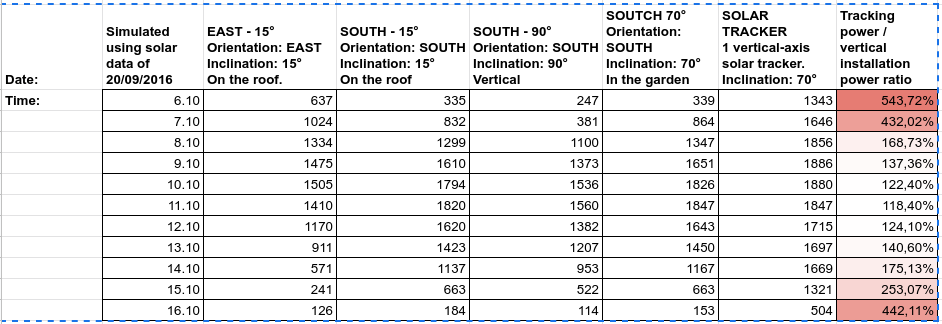
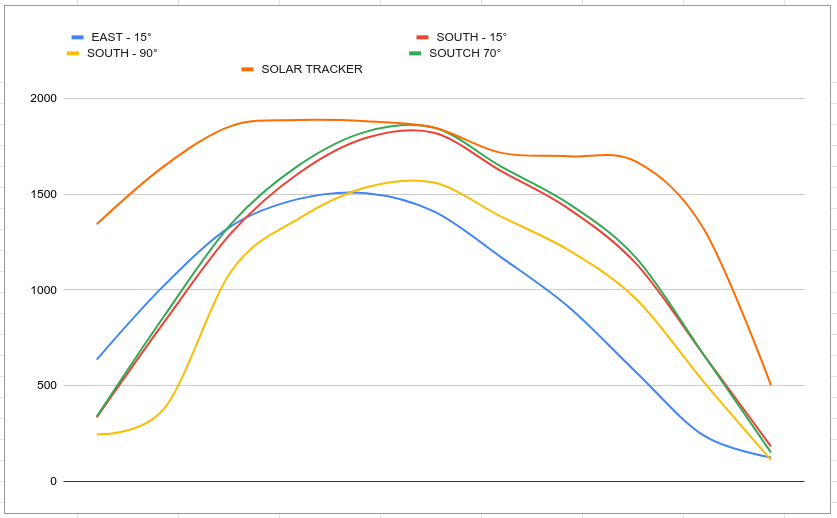
It's possible to see that best performances can be achived using a solar tracker... since from Sunrise, the tracking system lead to a very high power that permits to start heat pump without using power from the grid.
Simulation using data from 1 January 2016

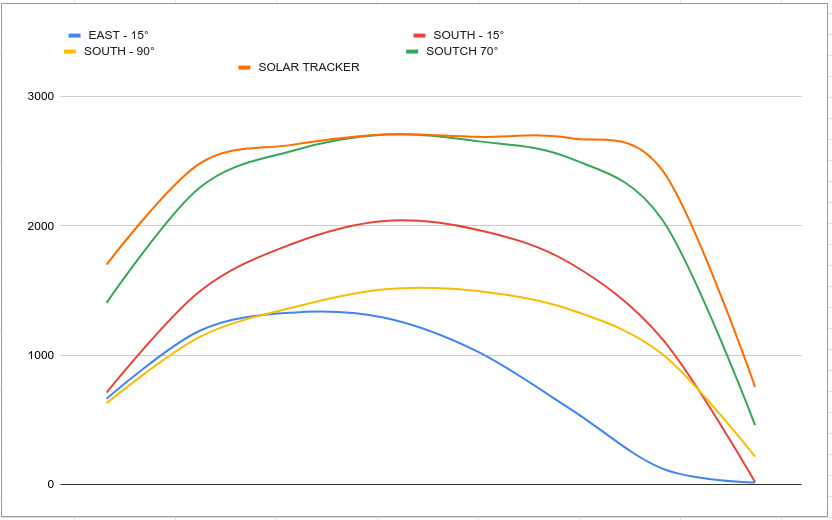
In this case, the solar tracking system does not help to improve the power, because the Sun in the Winter rise from south-east and fall to south-west.
Fotovoltaico in Italia, Scambio Sul Posto, remunerazione
Lo Scambio Sul Posto (SSP) è un meccanismo attraverso cui il Gestore dei Sistemi Energetici (GSE) remunera l'energia esportata in rete dai cittadini dotati di impianto solare fotovoltaico.
Spesso si sente dire che "è meglio consumare tutta l'energia prodotta", oppure "accumularla in batterie, perché il GSE non paga nulla". Ma è davvero così?
Se un impianto è dimensionato bene, è maggiore l'energia autoconsumata dell'energia esportata: in tal caso l'energia esportata viene pagata dal GSE in questo modo:
- suddivisione della produzione nelle fasce orarie F1, F2, F3
- per ciascuna fascia, viene moltiplicata l'energia mensile esportata in tale fascia per il Prezzo Unico Nazionale (PUN) medio mensile relativo a tale fascia oraria moltiplicata aumentata del 5% circa
Quindi, il GSE rimborsa, con lo Scambio Sul Posto: ( Export_F1 * PUN_F1 * 1.05 ) + ( Export_F2 * PUN_F2 * 1.05 ) + ( Export_F3 * PUN_F3 * 1.05 ).
Nell'area cliente del portale GSE è possibile vedere i calcoli eseguiti dal GSE sull'energia esportata e autoconsumata. Ad esempio a dicembre 2021 il PUN_F1 era di 0.32€/kWh, probabilmente ben al di sopra del prezzo di acquisto dell'energia elettrica (0.16€/kWh incluse tasse e contributi vari).
Normalmente, chi ha un impianto fotovoltaico esporta di giorno (quando il PUN + alto) e consuma di notte (quando il PUN è inferiore): il risultato è che conviene esportare l'energia anziché accumularla!
Dal punto di vista della remunerazione non cambia molto, tuttavia è preferibile cercar di esportare energia nelle fasce orarie in cui c'e' maggior richiesta: per questo vale la pena consultare, periodicamente, il Gestore Mercati Elettrici https://www.mercatoelettrico.org/it/
Nell'immagine si vede l'andamento del PUN, ora per ora, per l'8 settembre 2022: il PUN medio giornaliero risulta di 0.50€/kWh (500€/MWh) con punta di 0.70€/kWh alle 9 e 0.55€/kWh alle 20.

Il risultato che si evince è che l'accumulatore, per uso residenziale, ha senso SOLO per chi ha usufruito del Superbonus 110% (lo Stato ha finanziato tutto l'impianto, quindi non è giustamente prevista la remunerazione dell'energia esportata), a chi ha una potenza contrattuale troppo bassa per far funzionare gli elettrodomestici di casa (in tal caso l'accumulatore previene il distacco per superamento della potenza massima contrattuale) e a chi è disponibile a spendere per avere energia anche in caso di blackout. Negli altri casi è un costo che non sarà mai ripagato, tantopiù che il processo di ricarica della batteria e di conversione in alternata non hanno efficienza 100%, ma avviene sempre con perdita di energia.
Import / Export power and energy monitoring
Monitoring can be done by using the free and high-reliable home automation system controller Domoticz , one energy meter with pulsed output (like Eastron SDM-230) and a DomBus module (like DomBus12, DomBus23 or DomBusTH).
ToDo: schema
Domoticz collects data permitting to display charts comparing exported/imported energy month-by-month across several years.
The following chart shows the produced energy using a photovoltaic system, 7.2kWp on the roof, east and west orientation, in the last 3 years.
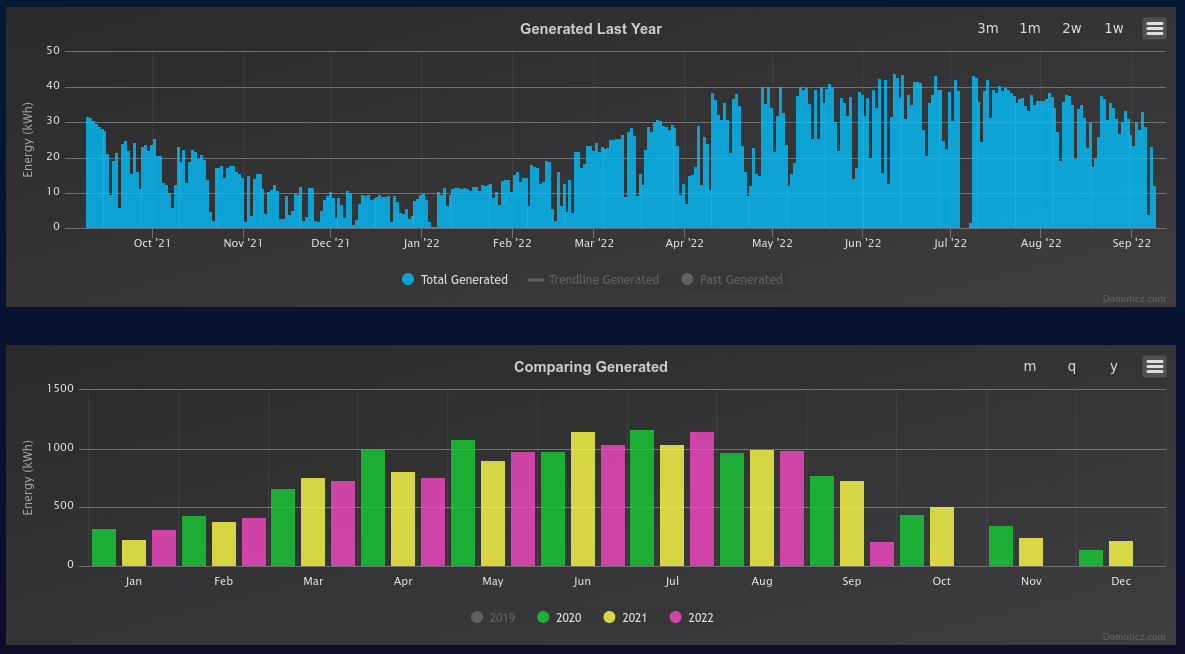
The following charts show the imported energy:

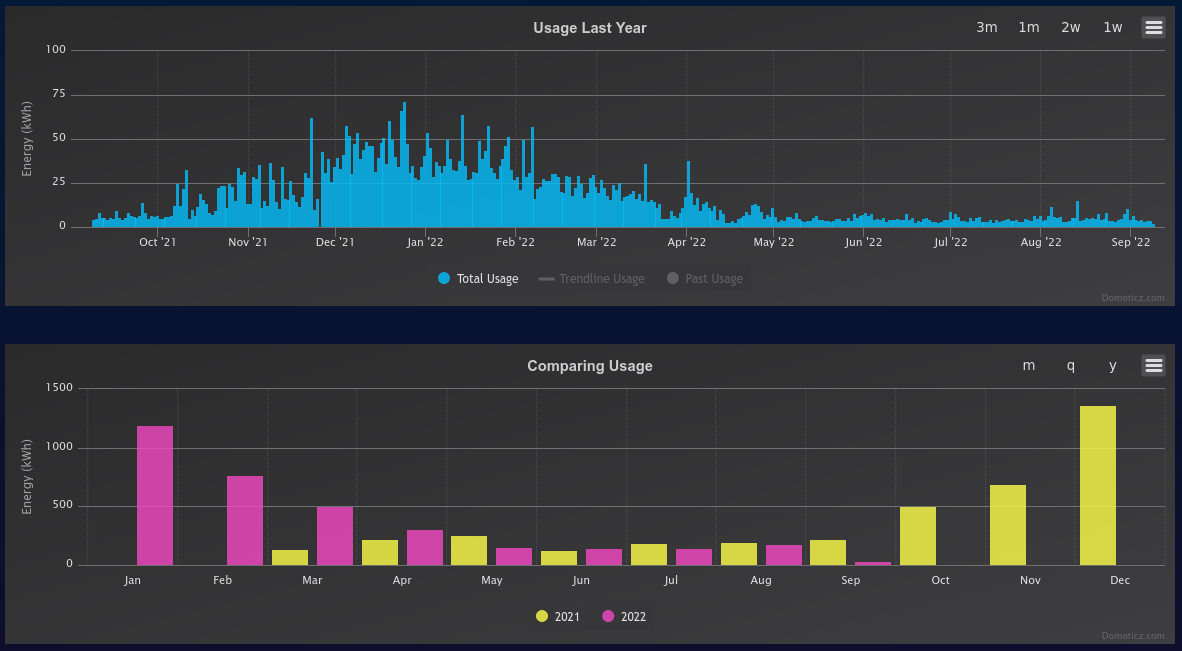
The following charts show the exported energy (energy sourced to the electric grid):
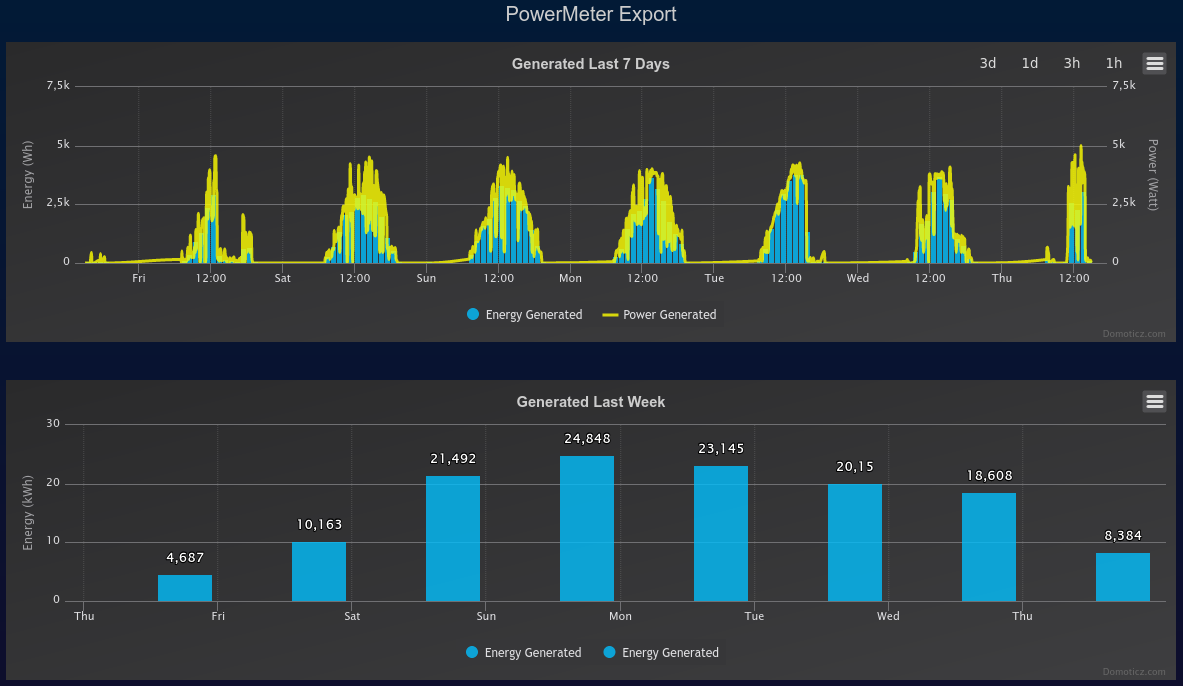

Comparison of photoltaic system: panels oriented to East and West, and panels oriented to South
The following graphs refers two different solar systems, mounted on roof in the North of Italy:
1) 2.7kWp oriented to East + 4.5kWp oriented to West (totally 7.2kWp)
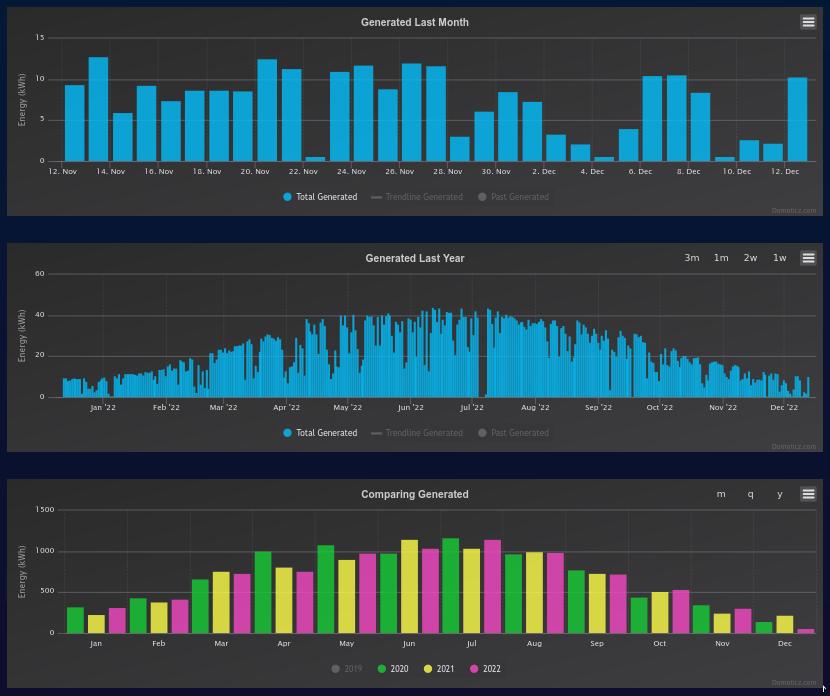
2) 6kWp oriented to South
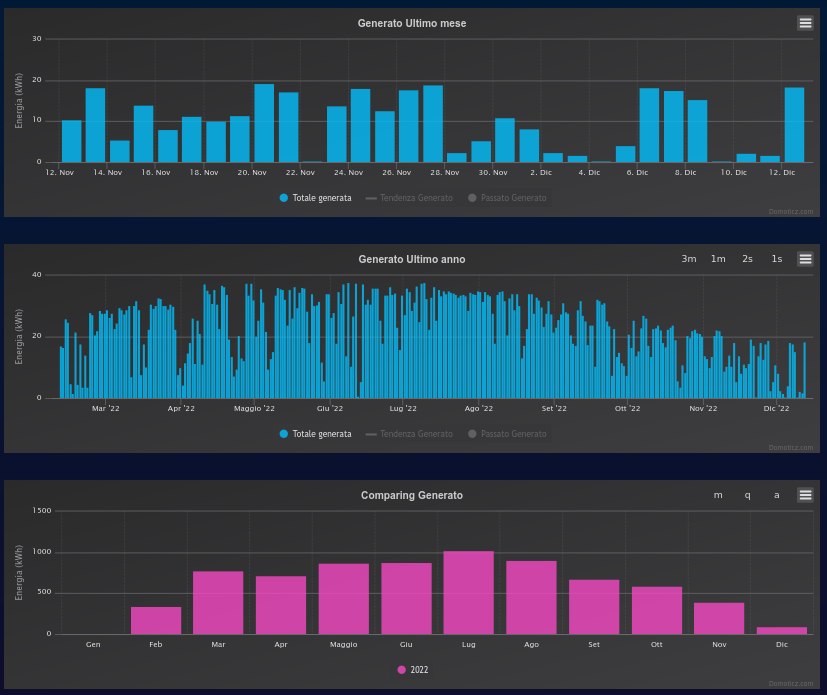
From the graphs it's clear
- in the Summer daily production is the same (44kWp for the first solution with 7.2kWp, 37kWp for the second with 6kWp)
- in the Winter, daily production of the second solution (panels oriented to South) performs more than double of the first solution (panels oriented to East and West).
Electric vehicles
Interested on electric vehicles? We have a page about electric cars with several FAQ, in Italian language.
Want to charge the electric car using our domotic module? Check https://www.creasol.it/EVSE

